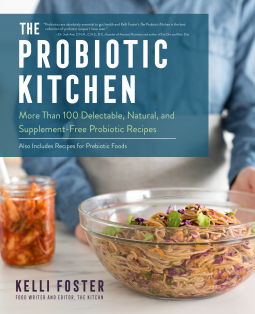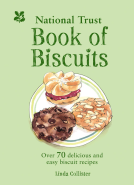
The Probiotic Kitchen
More Than 100 Delectable, Natural, and Supplement-Free Probiotic Recipes - Also Includes Recipes for Prebiotic Foods
by Kelli Foster
This title was previously available on NetGalley and is now archived.
Send NetGalley books directly to your Kindle or Kindle app
1
To read on a Kindle or Kindle app, please add kindle@netgalley.com as an approved email address to receive files in your Amazon account. Click here for step-by-step instructions.
2
Also find your Kindle email address within your Amazon account, and enter it here.
Pub Date 17 Dec 2019 | Archive Date 10 Dec 2019
Quarto Publishing Group – Harvard Common Press | Harvard Common Press
Talking about this book? Use #TheProbioticKitchen #NetGalley. More hashtag tips!
Description
Doctors and nutritionists firmly agree that probiotics are essential for everyday health and nutrition. Probiotics add "good bacteria" to the human gut. They crowd out "bad bacteria" and foster the absorption of nutrients through the intestinal walls. Everyone needs probiotics, just as they also need prebiotics, which make probiotics work. Probiotics also aid in the relief of chronic health issues, such as irritable bowel syndrome (IBS), as well as all kinds of occasional belly discomfort. They have anti-inflammatory properties, too.
Kelli Foster's The Probiotic Kitchen makes probiotic cooking easier and tastier than it's ever been before. Her recipes feature all the all-natural, probiotic-rich foods that are available now, from yogurts and aged cheeses to miso, kombucha, good old-fashioned pickles—and even chocolate. The more than 100 delectable and utterly appealing recipes in this book use these probiotic-rich ingredients to make incredibly tasty breakfasts, brunches, lunches, snacks, dinners, and desserts. The book includes:
- Lots of big-flavor main courses, like Cider-Glazed Pork Tenderloin with Sauerkraut and Apples, Fish Tacos with Kefir-Avocado Crema, and Mediterranean Stuffed Sweet Potatoes
- Substantial salads, such as Herbed Chickpea and Tomato Salad, vibrant soups, like Chilled Sweet Corn Soup with Pesto, and hearty sandwiches, such as Smoky Tempeh and Kale Caesar Wraps
- Recipes for prebiotic dishes and advice about how to add prebiotics to your meals, since prebiotics are needed for probiotics to work
- For busy cooks who eat on the fly, more than a dozen portable and delicious smoothies and similar drinks, plus easy-to-pack snacks and lunches
- Super versatile probiotic sauces, dressings, and condiments that you can use to turn any meal into a probiotic one, from a zesty Orange-Miso Vinaigrette to a sweet-and-sour Creamy Honey-Mustard Dressing
Marketing Plan
Campaign Focus: For optimum probiotic nutrition, it's time to say goodbye to supplements and pills and to bring all-natural, all-delicious, real-food probiotic (and prebiotic) meals into your life.
Key Selling Points: Gut health is big, in both the consumer market and the book market—it was the consensus number one trend across all 2019 trend predictions in the late 2018 food media Probiotics also aid in the relief of chronic health issues, such as irritable bowel syndrome (IBS), as well as occasional belly discomfort, and are recommended for a growing range of other uses, like the management of type 2 diabetes 100+ recipes include cheeses, green peas, and even chocolate, among many others. Author is editor at a top food site, theKitchn and author of Buddha Bowls
Key Campaign Activity Longlead feature pitch to top food and women’s magazines Review pitch to food editors at top national dailies Review pitch to top food and lifestyle online media
Pre-publication: Pitch to Buddha Bowls media hits Pre-order promotional campaign eblast to author’s subscriber list and twitter (1,300 followers) Eat Your Books giveaway Goodreads giveaway
Trade: Review copies to Library Journal, Publishers Weekly, Shelf Awareness
Retail: Digital review copy at NetGalley
Consumer: Outreach to top food & lifestyle blogs: goop, theKitchn, Oh She Glows, MindBodyGreen, PopSugar, Refinery29, SheKnows, Well+Good
Publicity/Media: Review copy push to targeted food, health and lifestyle online publications, including Clean Eating; CNN Health; Cooking Light; DrOz.com; Everyday Health; Fox News; Heath.com; Men’s Health; Organic Life; Natural Health; Paleo Magazine, Prevention; Shape; USA Today; Woman’s Health Review copy push to targeted newsprint, Boston Globe, Globe & Mail, Los Angeles Times, New York Times, Washington Post, Vancouver Sun, Seattle Times Promotion outreach to top food and health blogs, including goop; Live Energized; Mindbodygreen; Naturally Ella; Oprah.com; Pop Sugar; Tasting Table; Well+Good; Yahoo Food/Health
Available Editions
| EDITION | Other Format |
| ISBN | 9781558329898 |
| PRICE | US$24.99 (USD) |
| PAGES | 208 |
Average rating from 18 members
Featured Reviews
 Media/Journalist 16509
Media/Journalist 16509
It's important to know what this book is before purchasing. I thought it was a cookbook of more than 100 probiotic foods to make -- yogurts, kimchi, kefir, lacto-fermented butter, all kinds of krauts, and so on. That's not what this book is. The author does provide recipes for five fermented foods (fermented salsa, two krauts, mixed veggies and kimchi) but the rest of the book is recipes *using* fermented foods. For instance, there are sandwiches with sour kraut on them, breakfast bowls that include yogurt, and so on.
Recipes are divided into sections like breakfasts, lunches, snacks, sides, soups and desserts. Lovely color photos are provided, but only of about 1/3 or 1/4 of the recipes. No nutritional information is provided, which is rather disappointing for a health cookbook. Some recipes are vegan, vegetarian, paleo and/or gluten free, though none of these are the main theme. Vegans take note that the book features quite a lot of animal products (dairy, meat, seafood, etc.), though some recipes are vegan.
Examples of the recipes are: kimchi and avocado omelet, creamy breakfast barley, breakfast burritos with scrambled tofu and fermented salsa, beet-raspberry smoothie, tangy deviled eggs, banana-cardamom lassi, kombucha vinaigrette, dandelion pesto, kimchi chicken salad, avocado egg salad, almond butter and miso-jelly sandwiches, shredded kale and radicchio salad, creamy kale dip in a sourdough bowl, pear and whipped cheese crostini, fish tacos with kefir-avocado crema, honey mustard chicken thighs, cultured macro bowls, tempeh reuben, miso-butter baked potatoes, quick miso quinoa, strawberry yogurt ice pops, kombucha floats, and no-bake vanilla bean cheesecake.
All in all, this is a great cookbook if you are looking for creative ways to use cultured foods, especially if you tend towards these types of recipes.
I read a temporary digital ARC of this book for the purpose of review.
 Emma D, Reviewer
Emma D, Reviewer
Fabulous recipes and ideas for incorporating probiotics into your daily diet. Well written and cleverly designed, this book was comprehensive without being preachy.
 Reviewer 596926
Reviewer 596926
Thank you for allowing me to review this recipe book. My son needs to be on a probiotic diet and I was at a loss. This greatly expanded my horizons , I found quite a few recipes the entire family will enjoy!
 jc C, Educator
jc C, Educator
This is a great starter book for anyone wanting to learn about the benefits of including probiotics in their diet without resorting to supplements. It is a vibrant well laid out book with lots of pictures. I would probably have preferred more recipe pictures though, rather than the generic pictures of multiples of one type of food. The information is very good and you will be persuaded to make some changes even if you don't go full on into fermenting. The author has included lots of relevant information and research and does a very good job of convincing you of the benefits. It is a good book to browse through and some of the recipes are mouth watering.
A Tasty Source of Ideas
It's not hard to list the best sources of probiotics - live active culture yogurt, kimchi, sauerkraut, kefir, miso paste, tempeh, cultured cottage cheese, kombucha. This book offers an overview of those foods, summarizes the benefits of assuring your diet includes prebiotic and probiotic foods, and even takes a shot at teaching you how to make your own kraut. But the main thrust is to serve up a wide range of recipes that incorporate probiotics.
Suggestions are organized along the lines of breakfasts, smoothies and snacks, sauces and dressings, lunches, soups and salads, main dishes, sides, and desserts. Some of the recipes look interesting and tasty, some are obvious, and some are mostly just pretty presentations. But there is a lot of creativity and cheerful energy on display here, and certainly some nice ideas for those inclined to experiment. These recipes don't require exotic or hard to find ingredients, or expensive tools and appliances, so anyone can use this book to join the probiotic movement.
Now I can move beyond just drinking kefir out of the bottle. (Please note that I received a free advance will-self-destruct-in-x-days Adobe Digital copy of this book without a review requirement, or any influence regarding review content should I choose to post a review. Apart from that I have no connection at all to either the author or the publisher of this book.)
I think this book is a great start for someone who wants to know more about probiotic foods. This book gives you the basics and a few recipes to get you started in the world of fermented food.
The Probiotic Kitchen is a guide to improving the gut biome with recipes to utilize fermented and live culture ingredients into family friendly dishes which will also support and improve gut health. Due out 17th Dec 2019 from Quarto on their Harvard Common Press imprint, it's 208 pages and will be available in paperback and ebook formats.
It's important to note that this is a book which is written around -using- probiotic ingredients, and not specifically for making the fermented/processed ingredients themselves. It does include a basic recipe for 2 sauerkrauts, pickled vegetables, -very- basic kimchi, and fermented salsa.
The introduction (~7% of the content) covers some basic information about gastrointestinal health and the gut biome. There's also a short introduction to prebiotics and how (and why) to use them in conjunction with probiotics.
The following 2 chapters cover sourcing probiotics by buying them (chapter 1) or making your own with the basic recipes above (chapter 2). The rest of the book contains the recipes arranged thematically: breakfast, smoothies/drinks/snacks, dressings/sauces/condiments, lunch, soup/salad/appetizers, main dishes, sides, and desserts.
Each of the recipes includes an introductory description, ingredients listed in a bullet point sidebar (US measurements given, with metric in parentheses), and step by step instructions. There is no nutritional info provided. The recipes are photographed very well and clearly, with roughly 25% of the dishes shown in a photograph. Serving suggestions are attractive and appropriate. There are some vegan friendly recipes, but many aren't as they contain milk products and honey. There are some recipes which could be worked to make them AIP friendly also, but that's not a focus of the book, and auto-immune friendly recipes are not specifically mentioned.
The recipe ingredients themselves are easily sourced and will be available at most well stocked grocery stores.
The book does include a solid cross referenced index which includes ingredients.
This would be a good choice for people who are interested in experimenting with probiotic recipes who are either learning or don't feel the need to control the process from the very beginning and are willing to use already made ingredients. Many (most) of the recipes make small amounts (generally 2 servings except for main dishes which are 4+); but I don't see a problem with doubling or quadrupling the recipes.
Four stars.
I've been increasing the amount of probiotic food i eat over the years so i was delighted to recieve a review copy of this book. I've been trying the recepies for a while now and they are easy to make, tasty and varied. I love reading cooking books focused on specific types of cooking since they all allways, as did this book, provide me with new insights into how to incorporate types of cooking into my daily life. Theres a lot of variety here, from soups, snacks, salads, breakfasts, mains, sides, desserts etc. Everyone will be able to pick up a few tricks on how to incorporate probiotics into thier everyday cooking.
 Joanna M, Educator
Joanna M, Educator
I am always looking to incorporate more probiotic-rich foods and beverages into my diet to support my immune system. This book has the loveliest recipes! I especially look forward to trying the egg and dandelion greens toast, blueberries and cream overnight oats, and creamy meyer lemon pasta.
Thank you, Quarto Publishing Group and NetGalley!
The Probiotic Kitchen by Kelli Foster
More Than 100 Delectable, Natural, and Supplement-Free Probiotic Recipes - Also Includes Recipes for Prebiotic Foods
What I liked:
* Beautiful photographs
* Difference between prebiotics and probiotics and examples of what they are
* Ways to make a few probiotics from scratch and where to purchase them
* Clearly marked chapters with recipes included within the chapters
* Good index
* Creative recipes
What I did not like:
* The recipes are not ones I would make or if I could make them the ingredients are not always available where I live
* That prebiotic and probiotic ingredients in recipes were not indicated – it was assumed that the cook would know (could see color code or some other way of indicating these foods as helpful)
I would like to thank NetGalley and Quarto Publishing Group – Harvard Common Press for the ARC – This is my honest review.
3-4 Stars
 Diane H, Reviewer
Diane H, Reviewer
With breakfast, lunch, dinner, and desserts, The Probiotic Kitchen has a recipe for every need. Also included are smoothies, condiments, dressings, drinks, sauces, snacks, soups, salads, and appetizers.
But wait? What are probiotics and why should I eat them? Probiotics are live cultures that promote good gut health. The most common example is yogurt—though not all yogurt has the live active cultures that make it probiotic. Some other probiotic foods include kefir, kimchi, kombucha, miso paste, sauerkraut, tempeh, some cottage and hard aged cheeses, and pickles—but only the refrigerated kind.
While it may be easier to just buy these foods, the author suggests that making them at home is both cheap and easy. Starting with sauerkraut and moving up to kimchi and even salsa, the recipes look simple enough for me to try.
The rest of the recipes use ingredients from the store or farmer’s market. Some are surprising like a kimchi omelet, kombucha float, or barley risotto. Others are the more traditional Buddha bowls and vegan salads found elsewhere.
Once again, I am disappointed that no nutritional or allergen information was provided in The Probiotic Kitchen. However, the fermented salsa sounds just intriguing enough to get me to try making it. Maybe while sipping a blood orange kefir lassi? 3.5 stars rounded up to 4 stars!
Thanks to Harvard Common Press, Quarto and NetGalley for a copy in exchange for my honest review.
This publisher always produces beautifully designed books, and this one is no exception. I was hoping for more recipes for making your own probiotic foods, and while there are about 5 of those, most of the recipes are for other dishes that include probiotics and prebiotics. The ideas are appealing and attractively presented, rather than the stereotypical healthy food that looks like a punishment.
For a guide to planning your diet, nutritional and allergy information is conspicuously absent, although of course, there are many apps for that nowadays.
Thanks to Harvard Common Press, Quarto and NetGalley for a copy in exchange for my honest review.
Readers who liked this book also liked:
We Are Bookish
Mystery & Thrillers, OwnVoices, Teens & YA
Created by Hayao Miyazaki
Comics & Graphic Novels, Sci Fi & Fantasy
Linda Collister; National Trust Books
Cooking, Food & Wine, Crafts & Hobbies, Home & Garden


















